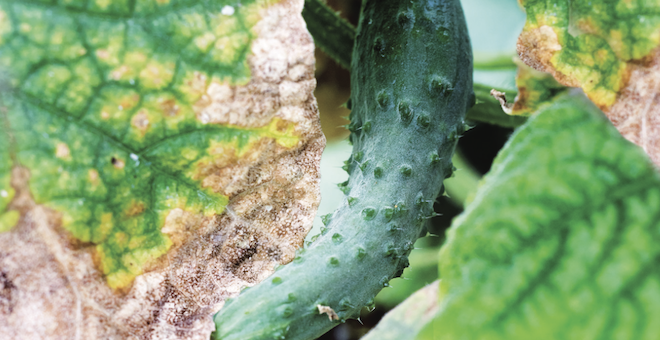
Mar 22, 2022Advances made against cucumber downy mildew
Downy mildew is the disease to beat in pickling cucumbers, and there are three questions to ask:
When do you begin fungicide applications?
What fungicide should be used?
Once a fungicide is sprayed, how many days between sprays?
Cucumber downy mildew doesn’t overwinter in Michigan or other areas that experience a killing frost. Knowing when the sporangia arrive by air currents from the southern states or from northern cucumber production greenhouses is critical to know when Michigan growers should begin their fungicide programs.
“Downy mildew is driven by weather and weather conditions,” said Mary Hausbeck, Michigan State University (MSU) vegetable pathology professor and Extension specialist. Hausbeck talked about downy mildew during the pickling cucumber session at the 2021 Great Lakes Fruit, Vegetable & Farm Market EXPO held recently in Grand Rapids, Michigan.
There have been some new advances. MSU had 13 stations in its spore trapping network in 2021. The stations were located in the cucumber production areas of the state and the results posted on MSU’s downy mildew, spore trap webpage.
The spores of the downy mildew pathogen that infects hops is also being monitored. Hop downy mildew is closely related to cucumber downy mildew, and the spores of these pathogens appear identical under a microscope.
Hop downy mildew overwinters in dormant buds or the crown of the hop plant and the spores of this pathogen can be in the air early in the spring. Since the spores of hop downy mildew and cucumber downy mildew cannot be distinguished from each other visually, it’s possible that an early detection of hop downy mildew spores would be mistaken for the arrival of cucumber downy mildew spores and trigger an earlier than needed fungicide program.
Molecular tools are now used exclusively in Michigan to conclusively identify cucumber downy mildew spores from hop downy mildew spores collected from the spore traps throughout the season. Using these tools allows the detection of even a low number of spores in the air.
“We are able to detect cucumber downy mildew spores before disease symptoms are detected in the field,” Hausbeck said.
MSU researchers use Burkard volumetric spore traps to monitor cucumber downy mildew spores in the air. The machine is outstanding, but is not always the easiest to use.
“The goal is to move toward a grower-based tool,” Hausbeck said.
Forecasting models – such as TOMCAST for use on tomato (early blight), but adapted for use on asparagus (purple spot) and carrot (leaf blight), Blitecast for potato and tomato (late blight), and DMCAST for grape (downy mildew) – have potential for use with cucumber downy mildew.
“Should spray intervals be five, seven or 10 days?” Hausbeck asked. “These programs may be able to help determine that.”
A robust fungicide program that alternates among different fungicides is required to control cucumber downy mildew. Each year, MSU conducts extensive field trials to assess which fungicides are effective and should be used by the state’s growers. The cucumber downy mildew pathogen is highly adaptable and has developed resistance to many fungicides over the last 15 years.
MSU researchers have conducted product trials and rated the amount of foliar infection.
“At the end of the season, Orondis Opti had near perfect control,” Hausbeck said. “This trial used a highly susceptible cucumber cultivar and was conducted for an extended time period under high disease pressure, so the results are especially impressive.”
Previcur Flex, Ranman and Omega were also highly effective in MSU’s 2021 trial. Zampro and Elumin also performed well in Michigan’s 2021 field trial, but offered more moderate control.
A downy mildew-specific fungicide must be tank mixed with a fungicide that has multi-site activity to delay the development of pathogen resistance. These products include Gavel, Zing!, Bravo WeatherStik and Koverall.
The preharvest interval (PHI) is an issue with some fungicides that are effective against cucumber downy mildew. An example is Omega, which has a PHI of 30 days.
A seven-day spray interval can be standard, but there can be instances when a shorter or longer spray interval would be appropriate.
“There have been times when a seven-day interval has not been adequate because the weather was highly favorable for disease,” Hausbeck said, “but how do you know when a five-day interval is needed to maintain control? When weather is less favorable for the pathogen, a 10-day interval may be sufficient.”
MSU recently conducted a field trial to determine whether some of the forecasting programs in use for other crops may be useful for cucumber downy mildew. The programs tested included TOMCAST, Blitecast and DMCAST. Each of these programs analyzes various weather conditions to determine whether the risk of disease is low, medium or high, and if a fungicide spray is needed. The MSU research field tests sought to find out if any of these programs could help to determine the number of days between sprays for cucumber downy mildew.
The models were evaluated under different disease severities and risk levels, and were compared to fungicide sprays applied according to a seven-day and 10-day calendar schedule. The models’ performances were acceptable in protecting cucumbers from downy mildew, although Blitecast and DMCAST did better than TOM-CAST, but more work on the models needs to be done.
“It makes sense to use them,” Hausbeck said, “if they can tell us how often to spray and can save growers money.”
In the meantime, the plan is clear. “Is the weather favorable for the pathogen? Then you need to spray,” Hausbeck said.
– Dean Peterson, VGN correspondent
















